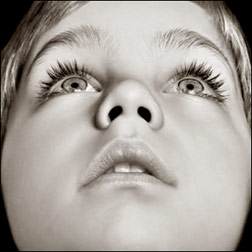
Marriages between blood relations could lead to cataract
Don't turn a blind eye:
by Shanika Sriyananda
Twenty-year-old Lingeshvari did not know much about the normal
functions of a human eye. She did not know that the eyes work like a
camera, which has lens that helps to focus the visual image.
 This mothers' instincts made her realise that her three-month-old
daughter's eyes were not normal. They were not crystal clear as others
but were clouded with a white haze. This mothers' instincts made her realise that her three-month-old
daughter's eyes were not normal. They were not crystal clear as others
but were clouded with a white haze.
Unlike other infants she did not respond to her mother but after a
while may be due to the natural smell of her mother she started crying
or smiling. Unfortunately Lingeshvari discovered her daughter's both
eyes were filled with white haze.
Living in Vakarai, which was under the control of the LTTE,
Lingeshvari, despite the war, took her daughter to the Batticaloa
Teaching Hospital, where the eye specialists recommended cataract
surgery. She was asked to find the money to buy two lenses but her
20-year-old husband, being a labourer who is her first cousin, could not
fulfil the requirement. Thanks to a foreign INGO, (She cannot remember
the name) her daughter was gifted with two lenses to see the world.
After living in a refugee camp until last year they have returned to
their homes March this year after the area was liberated by the Sri
Lankan military.
Packing her things to go home after a stay of more than a month at
the Colombo Eye Hospital, the young mother told the Sunday Observer that
her happiest day in her life was when her little daughter got vision
back. Now the one and half-year-old Nilushalini looks around with wide
open eyes. Still too young to understand, one day she will thank
everyone who had helped regain her vision.
Lingeshvari is married to her cousin and according to health experts,
marriages between close family members could have been a major cause for
childhood cataract.
"We do get children with cataract and in Sri Lankan it is mainly
hereditary. The chances for childhood cataract can be seen in marriages
between cousins", said Director of the Eye Hospital and Consultant Eye
Surgeon Dr. Champa Banagala.
She says that the most important thing is the early identification of
the illness. "Because the visual system develops very early in life.
This development starts after birth, around 8 weeks and until two and
half years. When the child is five years he or she will have a good
visual system", she says.
Dr. Banagala says "that if the child have anything that obstructs
normal visual system, steps taken to remedy late in life will not give
positive results in child's vision, especially when the problem is on
one eye.
"Because if you have little reduction in vision in both eyes the
brain get equal stimulation. If you have better vision in one eye that
eye dominates. Same thing happens when you have a squint in one eye. The
eye with squint does not see clearly and the good eye sees clearly.
After sometime, the brain forgets that there is another eye. Once it is
established whatever you do later to that eye to recover the vision the
child will not get that vision back".
She advises that if the parents think that the child does not see
clearly they have to consult an eye specialist immediately. She also
says that the condition will arise soon after the birth and with poor
fixation to mother's face would be an early sign of a problem in the
eyes.
"Usually the child see the mother's face after few weeks and if the
child does not respond and his eyes are just wandering all over, the
child is not seeing properly. Nowadays the mothers are very intelligent
and they pick it up. So the most important thing is to consult a doctor
as soon as possible when the mother sees these differences.
Not only parents but also the grand parents and maids could see
whether the child is normal with the vision.
Dr. Banagala says that earlier rubella was the main cause for the
congenital cataract but now due to wide coverage in rubella vaccine
programs the number of children who had cataract due to rubella has come
down.
According to Dr. Banagala now the most common cause for cataract in
very early childhood is mainly due to hereditary and apart from that
maternity infections like toxo plasma caused cataract but they are rare
causes. She says that there are children with abnormally formed eyes due
to other conditions.
However, the little children who are operated for cataract, have
vision for lifetime with Intra Oracular Lenses. Worldwide it was found
that the main cause for cataract, which has now become one of the known
eye problem, is the UV rays which are becoming more deadly at a rapid
rate. "It is advisable to wear hats and wear dark glasses when going
out", she says.
***
Your eyes do some great things for you, so take these steps to
protect them
* Wear goggles in classes where debris or chemicals could go flying,
such as wood shop, metal shop, science lab, or art.
* Wear eye protection when playing racquet ball, hockey, skiing, or
other sports that could injure your eyes.
* Wear sunglasses. Too much light can damage your eyes and cause
vision problems, such as cataracts, later in life. If the lens gets
cloudy, it's called a cataract. A cataract prevents light from reaching
the retina and makes it difficult to see.
The eyes you have will be yours forever. Treat them right and they
will never be out of sight!
How can parents, family, friends and teachers make a difference?
There are lots of things that can be done to help children with
cataract make the most of their vision.
We use our vision to get around, learn new things and to meet other
people and make friends. It is important to consider what your child's
particular problems with vision might be now and in the future.
If your child has been prescribed spectacles, contact lenses or a Low
Visual Aid (LVA) it is important that they are encouraged to wear and
use them. This will help your child see more clearly and ensure the
vision parts of the brain grow and develop.
Wearing a hat and tinted glasses can also help reduce symptoms of
photophobia (dislike of bright light). If your child has also been
prescribed drops they should be used regularly as advised by the nurses
and doctors at the eye clinic.
Problems at school may be due to some of the reading books being hard
to see. This often means it takes longer and more effort to do the work.
If the size of print is increased and letters and words spaced more
widely most children will find school work easier.
Good bright lighting and crisp black print on a clean white
background will also make things easier. Sometimes placing reading books
on a slope, which tilts the print towards the child, will improve
reading speed as well.
When reading it can be helpful to read one line at a time through a
'letter box' placed over the page. Placing a piece of blue tack below
the line they are reading, at the beginning of the next sentence, can
help some children find their way back to the start of the next line
more quickly.
It is also worth watching carefully to find out what the smallest
toys are that a child can see and play with. Then try to only play with
toys that are the same size or bigger.
Placing one toy on a plain background will often help children see it
more readily. Placing lots of toys of different size and colour close
together on a patterned background can make them more difficult to see.
Recognising facial expressions can often be difficult. It is worth
trying to find out at what distance facial expressions can be seen and
responded to. Then always try to talk and smile from within this
distance. This helps a child to learn what facial expressions mean and
to copy them.
Infants and young children need to learn about the world around them.
Home visiting teachers, physiotherapists and occupational and speech
therapists may all add to the child's care and education. It is
important to continue the programmes that they recommend. If the child
is involved in family activities vision can improve and new skills can
develop.
Even if a child has very poor vision many useful and practical things
can be done to improve the ability of the child to get around, interact
with other children and learn.
Kidshealth.com
|
